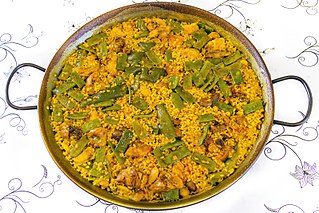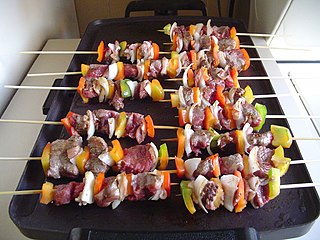Related Research Articles

Paella is a rice dish originally from the Valencian Community. Paella is regarded as one of the community's identifying symbols. It is one of the best-known dishes in Spanish cuisine.

A sausage is a type of meat product usually made from ground meat—often pork, beef, or poultry—along with salt, spices and other flavourings. Other ingredients, such as grains or breadcrumbs may be included as fillers or extenders.

Tripe is a type of edible lining from the stomachs of various farm animals. Most tripe is from cattle, pigs and sheep.

Chorizo is a type of pork sausage originating from the Iberian Peninsula. It is made in many national and regional varieties in several countries on different continents. Some of these varieties are quite different from each other, occasionally leading to confusion or disagreements over the names and identities of the products in question.

Fried rice is a dish of cooked rice that has been stir-fried in a wok or a frying pan and is usually mixed with other ingredients such as eggs, vegetables, seafood, or meat. It is often eaten by itself or as an accompaniment to another dish. Fried rice is a popular component of East Asian, Southeast Asian and certain South Asian cuisines, as well as a staple national dish of Indonesia. As a homemade dish, fried rice is typically made with ingredients left over from other dishes, leading to countless variations. Fried rice first developed during the Sui Dynasty in China.

Filipino cuisine is composed of the cuisines of more than a hundred distinct ethnolinguistic groups found throughout the Philippine archipelago. A majority of mainstream Filipino dishes that compose Filipino cuisine are from the food traditions of various ethnolinguistic groups and tribes of the archipelago, including the Ilocano, Pangasinan, Kapampangan, Tagalog, Bicolano, Visayan, Chavacano and Maranao ethnolinguistic groups. The dishes associated with these groups evolved over the centuries from a largely indigenous base shared with maritime Southeast Asia with varied influences from Chinese, Spanish and American cuisines, in line with the major waves of influence that had enriched the cultures of the archipelago and adapted using indigenous ingredients to meet local preferences.

Pancit, also spelled pansít, is a general term referring to various traditional noodle dishes in Filipino cuisine. There are numerous types of pancit, often named based on the noodles used, method of cooking, place of origin, equal and constant diameter or the ingredients. Most pancit dishes are characteristically served with calamansi, as its freshly squeezed juice may be used for additional seasoning.

Chinese sausage is a generic term referring to the many different types of sausages originating in China. The southern flavor of Chinese sausage is commonly known by its Cantonese name lap cheong.

Honduran cuisine is a fusion of Mesoamerican, Spanish, Caribbean and African cuisines. There are also dishes from the Garifuna people. Coconut and coconut milk are featured in both sweet and savory dishes. Regional specialties include sopa de caracol, fried fish, tamales, carne asada and baleadas. Other popular dishes include meat roasted with chismol and carne asada, chicken with rice and corn, and fried fish with pickled onions and jalapeños. In the coastal areas and the Bay Islands, seafood and some meats are prepared in many ways, including with coconut milk. Among the soups the Hondurans enjoy are bean soup, mondongo soup, seafood soups and beef soups. Generally all of these soups are mixed with plantains, yuca, and cabbage, and served with corn tortillas.

Longaniza is a Spanish sausage (embutido) similar to a chorizo and also closely associated with the Portuguese linguiça. Its defining characteristics are interpreted differently from region to region. It is popular in the cuisines of several regions of Spain, Argentina, Uruguay, Puerto Rico, Dominican Republic, El Salvador, Guatemala, Mexico and Chile. In the Philippines, it is called longganisa and has hundreds of variants with different vernacular tastes and forms due to the 144 ethno-linguistic groups of the archipelago.

Arroz a la valenciana or Valencian rice is a name for a multitude of rice dishes from diverse cuisines of the world, which originate from the rice-cooking tradition of the Valencian Community, in eastern Spain.

Sinangag, also called garlic fried rice or garlic rice, is a Filipino fried rice dish cooked by stir-frying pre-cooked rice with garlic. The rice used is preferably stale, usually leftover cooked rice from the previous day, as it results in rice that is slightly fermented and firmer. It is garnished with toasted garlic, rock salt, black pepper and sometimes chopped scallions. The rice grains are ideally loose and not stuck together.

The Eurasian cuisine is a 'fusion' cuisine, mainly existing and found in the countries of Singapore and Malaysia.

Embutido, or embotido, is a Philippine meatloaf made with ground pork and stuffed with hard-boiled eggs and sliced ham or various sausages. It is traditionally wrapped in aluminum foil and steamed, though it can also be baked.

Morcón or morconito, is a Philippine braised beef roulade made with beef flank steak stuffed with hard-boiled eggs, carrots, pickled cucumber, cheese, and various sausages. It is commonly served during Christmas and other festive occasions.

Paelya or paella (Spanish), is a Philippine rice dish adapted from the Valencian paella. However, it differs significantly in its use of native glutinous rice (malagkít), giving it a soft and sticky texture, unlike the al dente texture favoured in Spanish paella. It is also characteristically topped with sliced eggs. Filipino paelya does not use saffron, but is instead coloured with atsuete (anatto), luyang diláw (turmeric), or kasubhâ (safflower).

Chorizo de Macao, sometimes called Chinese Chorizo or Longaniza Macau, is a Filipino dry pork sausage. The ingredients of Chorizo de Macao is identical to other Filipino sweet longganisas, except for its dry texture and its use of star anise, aniseed, or anise liqueur (anisado), which gives it its distinctive aroma and its name. It is commonly used in Chinese Filipino dishes like pancit Canton and siopao. It is sometimes confused with and used in place of Chinese sausage.
References
- ↑ Polistico, Edgie (2017). Philippine Food, Cooking, & Dining Dictionary. Anvil Publishing, Inc. ISBN 9786214200870.
